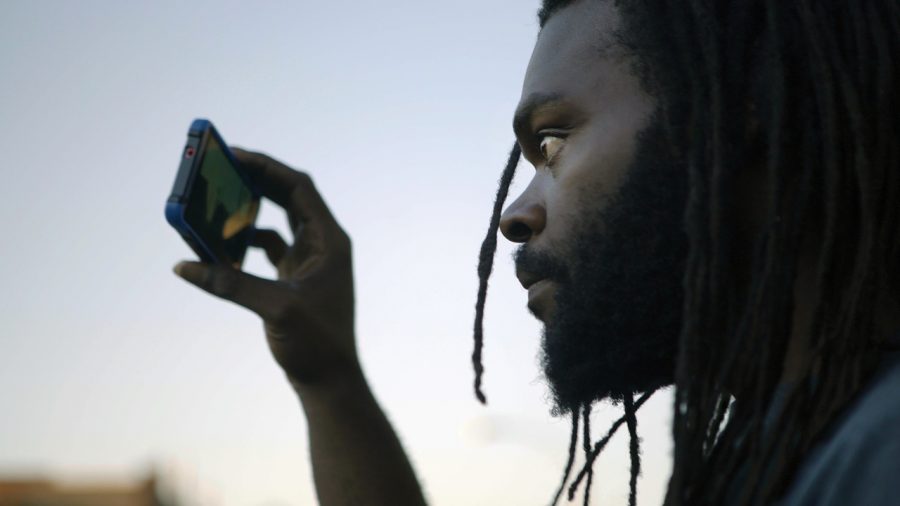‘Copwatch’ Shows the Importance of Filming Police Brutality
Kevin Moore keeps a trained eye on the police as a cop-watcher to film acts of police brutality (Courtesy Tribeca Film Festival)
June 8, 2020
In 1991, Rodney King was brutally beaten by LAPD officers during his arrest. Upon hearing King’s yells, George Holliday grabbed his video camera and filmed what the police were doing to King. This incident marked one of the first times that police brutality was captured — and it later inspired the 1992 Los Angeles riots. After seeing recordings of police shooting Oscar Grant in 2009, documentary filmmaker Jacob Crawford was inspired to create We Copwatch to further encourage individuals to grab their camera during moments of police brutality.
Camilla Hall’s documentary “Copwatch” follows Crawford and other cop-watchers as they film and face the consequences of recording police brutality. Names like Michael Brown, Freddie Gray and Eric Garner stand out in history as key moments of police abusing their power. In the cases of Freddie Gray and Eric Garner, however, the public is only aware of these cases because of the power of the camera. Kevin Moore and Ramsey Orta, respectively, were responsible for our public awareness of these cases. Although they had not heard of We Copwatch, their instinct was to grab their camera to record the police brutality they had witnessed. In both cases, Moore and Orta faced extreme consequences after their videos went viral.
In 2014, following the riots after Michael Brown’s murder, Crawford traveled to Ferguson, Missouri to spread the message of We Copwatch. Hall’s documentary focuses on Crawford and Ferguson local David Whitt as they worked together to build up We Copwatch and start a GoFundMe to supply community members with cameras. Several scenes of the documentary focus on the two as they inform others of their constitutional right to record the police. After coaching others on what to do if they witness an act of police brutality, it is clear to see individuals leaving with a sense of empowerment. Crawford states in the documentary, “As long as there’s problems with police,” he will keep encouraging people to film any injustices they see. Crawford acknowledges that We Copwatch is not a solution, but it is a start in promoting awareness, which is always the first step towards making real change.
The documentary also follows the consequences Moore and Orta faced after their respective videos entered the public consciousness. Both were arrested and Orta was pressed with additional charges and allegations of other crimes after filming Garner’s death. The documentary showcases Moore and Orta’s friendship as Moore helps Orta through each additional allegation brought against him. Different from the other cases presented in the documentary, Orta knew Garner, and his descriptions of Garner and their friendship are truly heartbreaking. Even though both Moore and Orta received backlash following the videos they recorded, they each said they would do it again — the public awareness of police brutality far outweighs any consequence they individually face.
In one telling moment, Moore realizes that “there’s plenty more Freddie Grays that happened after Freddie Gray.” Given our current discord and the protests that have occurred after George Floyd’s murder, Moore’s statement has taken on a profound meaning. In just the past few weeks, the names George Floyd, Ahmaud Arbery and Breonna Taylor have filled current news cycles — and in the cases of Floyd and Arbery, would we know about these cases if not for the recordings that were released?
“Copwatch” was initially released in 2017 at the Tribeca Film Festival, where it won Best Documentary Feature. Despite the time that has passed, surprisingly not much has changed. Crawford and Whitt’s efforts to encourage more cop-watchers remains as necessary as ever. Throughout the film, we repeatedly see Whitt making sure that Michael Brown’s memorial in Ferguson stays up — he won’t let people forget about Brown. But as he updates the memorial, he includes more and more names of other Black people who have been wrongfully murdered by police — Whitt writes the names of Sandra Bland, Tamir Rice, Alton Sterling and countless others upon the stuffed animals that he places around the memorial.
Some scenes of “Copwatch” are triggering as they include the very videos that brought many cases of police brutality to light. While these violent scenes are difficult to watch, it is important to be aware of exactly what is going on in our country. Even though not much has changed, Crawford and Whitt’s message to keep your eyes open and to grab your camera when injustice may be happening is incredibly profound. The documentary’s success lies in this empowerment it gives the audience — of any race — and the human features with Moore and Orta showcase the deep injustices that Black Americans face.
I was able to see this documentary because it was a last-minute addition to the We Are One: A Global Film Festival, but I was disheartened to see that “Copwatch” was only available for a one-time viewing. Even though it wasn’t originally a part of the festival, its messages constantly remain important, and it would be inspiring to see this documentary become more widely available.
After the failure to convict any of the officers involved in Freddie Gray’s murder, Baltimore City State’s Attorney Marilyn Mosby said, “Justice is always worth the price paid for its pursuit.” As more people become cop-watchers or pull out their cameras to record acts of injustice, we must remain dedicated to pursuing justice and encouraging social change.








